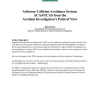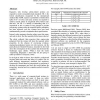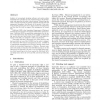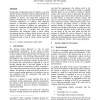SCS
2004
14 years 4 months ago
2004
Limitations in scope but also difficulties with the efficiency and scalability of present algorithms seem to have so far limited the industrial uptake of existing automated FMEA t...
SCS
2004
14 years 4 months ago
2004
Commercial-Off-The-Shelf (COTS) software components are being used within complex safety-critical applications. However, to use them with confidence, it is necessary to ensure tha...
SCS
2004
14 years 4 months ago
2004
SCS
2004
14 years 4 months ago
2004
Engineers who develop safety-related systems are required to work to remarkably high standards: SIL 1, the lowest classification recognised by the international standard IEC 61508...
SCS
2004
14 years 4 months ago
2004
Complex reactive real time systems are systems of systems that interact with the external world to perform selections of tasks in real time. They may be required to carry out sele...
SCS
2004
14 years 4 months ago
2004
Railways, like a lot of industries are becoming increasingly reliant on programmable technology for safety. The development of railway technology is however largely driven through...
SCS
2004
14 years 4 months ago
2004
Sociotechnical systems are those which rely not only on technology but on humans and social organisation for their adequate functioning. The analysis of sociotechnical systems pose...
SCS
2004
14 years 4 months ago
2004
Many transport policies and innovations are liable to have implications for human health and safety. How should such implications be weighed against the other costs and benefits? ...
SCS
2004
14 years 4 months ago
2004
Industry is increasingly adopting software and system safety standards that mandate the use of hazard logs in the development and operation of safety critical systems. Hazard logs...
SCS
2004
14 years 4 months ago
2004
In this paper I examine the issue of whether we can trust software systems and put forward an argument that in an absolute sense the answer must necessarily be no for a multitude ...




